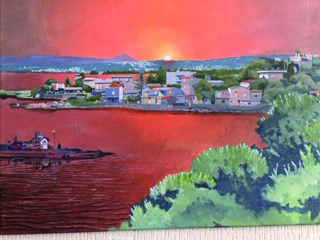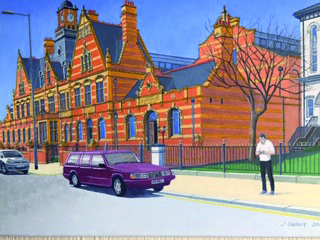Joe Gellert is a former private practice architect living in Whitefield. Since his retirement he has continued to pursue an interest in artistic representation developed throughout his distinguished architectural career. The subjects of his paintings range from local townscapes to commissions of private houses, a number of which have been exhibited at Bury Art Gallery and are owned by collectors throughout Europe and the US.
Hi Joe, so tell us what you’ve been up to since we last spoke in JLife Manchester!
The last three months have been a very busy time for me. In early September, my wife Judy and I returned to Manchester from a short holiday in Crete, where we visited Knossos and the museum of the Minoan civilisation located there. Since then, I have produced three new paintings, and am currently nearing completion of a full colour painting of the Great Northern Tower precinct in the city centre.
Following my temporary break during the Yomim Tovim, I have returned to the Eccles Art Group, in which I participate on a weekly basis. I also attend a local gym three times a week – ‘a healthy mind is a healthy body’ is the philosophy that I adopt. I additionally try to cover six to eight miles of high speed walking on a weekly basis whenever the weather permits. As I wander, I am always looking for interesting streetscapes and atmospheric landscapes to portray.
Have the longer nights and winter weather affected your art?
As each painting takes between 200 and 250 hours to produce, the recent inclement weather has afforded me the opportunity to concentrate on my artwork, though I do appreciate the warm summer weather and the longer, lighter days (when they eventually arrive). I realise that Manchester is renowned for its rain and by creating my paintings with blue skies, I try to create images that provide a much-needed ‘feel good factor’!
As a former architect, do you feel compelled to adhere to realism?
Whenever I start, I always stick to my old habits of drawing my subject matter in HB pencil using an architectural scale rule to ensure accuracy. I will also establish the positions of the vanishing points to ensure that the perspective that I create is accurate and free of the distortions often evident on the photos used as the basis of my paintings.
However, I do use artistic license to provide an image that is well balanced, often moving elements slightly, but ensuring that the main subject of the painting is visually realistic. I often enhance the colours of the buildings in order to show the original colours of the brickwork or stonework as new. I find badly weathered buildings are not aesthetically pleasing – and as most notable buildings are renovated and cleaned periodically, I feel this in a way reflects the architecture as its designer intended.
How has your use of materials changed throughout your artistic career?
Over the years, I have gradually moved from watercolour painting to acrylics, and recently I have started to use water-based oils, which give me much greater flexibility with my painting techniques.
Once the drawing is complete I use water-based oils to bring the drawing to life. The skies are the first to be painted, and these are generally graded to become lighter as I work down the painting, much like the natural grading of skies. I always work down from the top of the painting as water-based oils take several days to dry, and can easily be smudged if you initially start working lower down the painting.
Can you tell us about some of your recently completed work?

Crete Sunrise is painted in water-based oils on a 600x 500mm pre-framed canvas.
This is a full colour sunrise scene based upon a photo that I took in Crete. The island on the left hand side of the painting has been moved slightly to the right so that it could be incorporated into the painting, thereby creating a balance.

The Victoria Baths is painted in water-based oils on a 600 x 450mm pre-framed canvas.
This is a full colour painting of the Victoria Baths in Chorlton. The old Volvo Estate in the foreground was actually right outside the baths, though I have moved it to the side for emphasis purposes. I could not believe my luck that such an appropriate car was standing against the backdrop of this magnificent renovated Victorian building!

The John Rylands Library is painted in pen and ink and water-based oils on a 600 x 500mm pre-framed canvas.
Having previously painted the Rylands Library in full colour, I decided to paint the same view again in black and white, as I felt that a pen and ink version would enhance the wonderful architectural aesthetic of this magnificent Gothic masterpiece.
In the short period that had elapsed since I painted the original coloured version of this building, the office development at the right hand edge of my original painting had been demolished and a new building was under construction. I decided to omit the subsequently demolished building from my latest painting and I feel that this enhances the composition. This painting also contains limited use of water-based oils so as not to detract from the main subject.
To exhibit or purchase Joe’s work, or to pitch a commission, visit Joegellertart.co.uk

